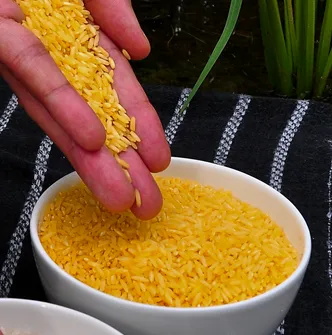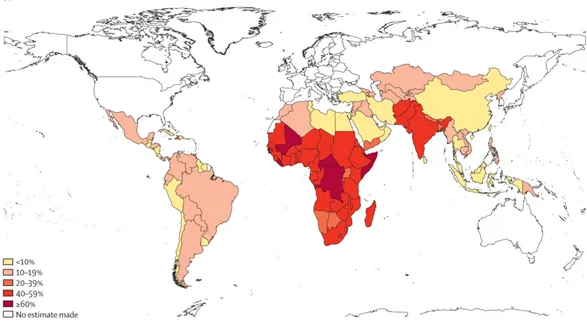Today I want to highlight a GMO food that has the potential to save many lives. I’m worried about the response to this post because the artificial genetic modification of organisms (GMOs for short) is a hotly contested issue with a lot of misinformation. Still, I feel that this issue is important enough that I should contribute. Although I support GMOs, I understand why many are concerned. The science can be difficult to explain, and the idea of changing something in nature just seems wrong in a way. It’s a negative emotional reaction that even I’m not immune to despite my logical side thinking they’re fine. I also want to emphasize that I’m not going to defend all the shit corporations have done sell GMO crops. They’ve made this GMO debate a hell of a lot worse by doing all the crappy things that corporations are known to do.
I’ve though a lot about how to contribute to this discussion. I didn’t want to highlight studies showing them to be safe. A bunch of other articles that already do a great job at this (1). I also didn’t want to explain how GMOs are engineered as SteemSTEM members @suesa and @justtryme90 have both done a great job at objectively explaining this process (2, 3). Instead, I want to focus on the benefits they can bring to society. The goal here is to give readers a positive emotional response they can associate with GMOs to counter the negative emotional reaction they might already have. Enter golden rice.
What is golden rice?

Golden rice. Image adapted from (4).
Golden rice is a strain of rice genetically engineered to synthesize provitamin A, also known as beta-carotene (4). This vitamin is naturally found in many plants, such as carrots and corn, and has a distinct yellow/orange color responsible for giving these plants their color. This is where the name “golden rice” derives from as the synthesis of beta-carotene turns the rice yellow.
In order to create golden rice, scientist inserted four genes into the rice genome encoding the enzymes phytoene synthase, phytoene desaturase, zeta-carotene desaturase, and lycopene beta-cyclase. When the four enzymes are expressed together, they create beta-carotene from common metabolic products.

The metabolic synthesis of beta-carotene. Adapted from (5)
I want to emphasize that these enzymes were not chosen on a whim. Each class of enzyme has been, and continues to be, extensively researched. For example, phytoene desaturase was discovered in 1976 (6), searching for it in google scholar gives almost 10,000 results (7), and pubmed can find 72 articles with that name in the title itself. Three of the enzymes come from the genomes of other edible plants, but carotene desaturase originates from the bacteria Erwinia uredovora.
The bacterial origin of carotene desaturase is the most unsettling aspect of golden rice for a lot of people so I want to take some time to explain it. It might seem weird that scientists put bacteria DNA in to a plant, but it’s a single gene encoding one enzyme that performs a very specific task. No other bacterial DNA was introduced into the plant and the gene itself can’t really do anything other than make beta-carotene. In fact, using this gene helped minimize the genetic modification needed to create golden rice. It was chosen because it can actually perform three desaturase reactions that plants usually use three distinctive enzymes for (8).
Initial attempts at creating golden rice succeeded in 2000 (9). However, improved golden rice strains continue to be developed to increase beta-carotene content and to make it competitive with other commonly farmed rice varieties (10). Currently, a single cup of golden rice (150 grams) provides half the recommended daily allowance of vitamin A for an adult (11) and no study has found any tangible health or safety concerns with golden rice (12).
Why is this important

A 12 year old girl suffering from blindness caused by vitamin A deficiency. Adapted from (13).
Now for everyone who has reservations about GMOs keep the following malnutrition and death statistics in mind. A 2015 study estimates that 29% of children in low- or middle-income countries are vitamin A deficient and 1.7% of deaths in all children under 5 years old are due to lack of vitamin A (14). This comes to over 100,000 child deaths a year. Its perfectly understandable to be concerned with GMO foods, to ask questions about how they’re created, and to demand regulation. However, active pushback against products like golden rice can demonstrably lead to child mortality and shouldn’t be done lightly.

Prevalence of vitamin A deficiency in children under 5 years old in 2013. Adapted from (14)
If golden rice is so great, why hasn’t it saved any lives yet?
Controversy is probably the single biggest issue holding golden rice back. Public outcry against all GMOs, whether warranted or not, have resulted in significantly increase regulation on GMO products like golden rice. Many countries are reluctant to allow farmers to grow them. Fortunately, multiple food safety agencies, Including the US FDA and the New Zealand equivalent, have determine that there are not health or safety concerns with golden rice (15). Applications to grown them in the Philippines, where they could be incredibly beneficial, are underway. Even better, golden rice is free to use for subsistence farmers (16).
Conclusion
The thesis of this article can be summarized below
- Vitamin A deficiency causes over 100,000 deaths in children annually
- Golden rice is designed to provide vitamin A to these children
- No health or safety concerns have been associated with this GMO
Now you may notice that I’ve consciously avoided going deep into the science or countering anti-GMO talking points. This is intentional because I want to focus on just one message:
GMOs can save lives
Millions of people in impoverished countries are suffering from nutrient deficiency and GMOs might be the only viable solution. Crops with increased resilience, faster growth, or supplemental nutrient production help them and golden rice is an excellent example to illustrate this point. I hope that message gets through to anyone reading this, whether pro-or anti-GMO.
Images
All images used have been labelled for re-use by Wikipedia or Flickr, or are taken directly from the publication referenced. If any image owner has an issue with this article, please contact me and I will address the issue.
Sources
(1) https://geneticliteracyproject.org/2017/06/19/gmo-20-year-safety-endorsement-280-science-institutions-more-3000-studies/ - thanks to @scienceangel for this link
(2) https://steemit.com/science/@suesa/wtf-is-a-gmo
(3) https://steemit.com/science/@justtryme90/science-lesson-genetically-modified-organisms-how-are-gmos-created
(4) https://en.wikipedia.org/wiki/Golden_rice
(5) http://jn.nutrition.org/content/132/3/506S.full
(6) http://www.nrcresearchpress.com/doi/abs/10.1139/o76-117#.WnH1HainGUk
(7) https://scholar.google.com/scholar?hl=en&as_sdt=0%2C22&q=%22phytoene+desaturase%22&btnG=&oq=ph
(8) https://academic.oup.com/jxb/article/57/4/1007/558906
(9) http://science.sciencemag.org/content/287/5451/303
(10) https://www.nature.com/articles/nbt1082
(11) http://ajcn.nutrition.org/content/89/6/1776.full
(12) https://www.sciencedirect.com/science/article/pii/S0958166916302488
(13) https://www.flickr.com/photos/communityeyehealth/5492473278
(14) https://www.sciencedirect.com/science/article/pii/S2214109X1500039X
(15) http://irri.org/golden-rice/faqs/what-is-the-status-of-the-golden-rice-project
(16) https://en.wikipedia.org/wiki/Golden_rice
SteemSTEM
I’m a proud member of the @steemstem community and I encourage you to join. SteemSTEM is a community driven project which seeks to promote well written/informative Science Technology Engineering and Mathematics postings on Steemit. The project not only curates STEM posts on the platform through both voting and resteeming, but also re-distributes curation rewards as STEEM Power, to members of Steemit's growing scientific/tech community.
